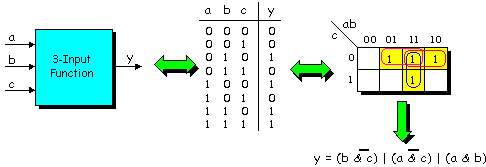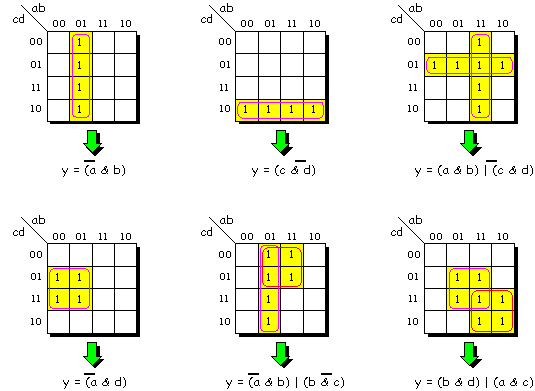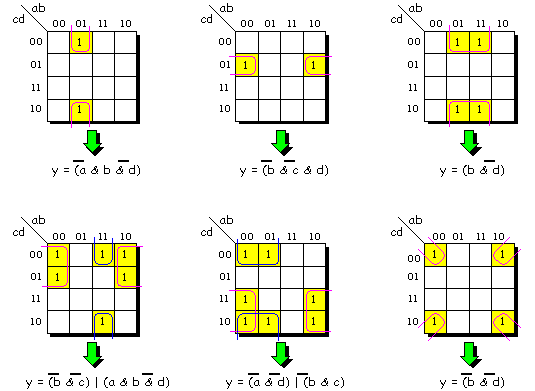|
|
|
 |
| These discussions were abstracted from the book, Bebop to the Boolean Boogie (An Unconventional Guide to Electronics), with the kind permission of LLH Technology Publishing, Eagle Rock, VA, USA. Bebop to the Boolean Boogie provides a superb introduction to a smorgasbord of contempory digital electronics, including atoms, transistors, logic gates, Eskimo counting systems, fuzzbuttons, smoked fish, musical socks, Reed-Müller logic, seafood gumbo, integrated circuits, circuit boards, hybrids, multichip modules, optical interconnects, protein memories & switches, holographic interconnects, superconductors, nanotechnology, and much, much more! |
| Karnaugh Maps Part 3: Grouping Minterms |
| In
the case of a 3-input Karnaugh map, any
two horizontally or vertically adjacent minterms, each composed of three
variables, can be combined to form a new product term composed of only
two variables.
Similarly, in the case of a 4-input map, any two adjacent minterms, each composed of four variables, can be combined to form a new product term composed of only three variables. Additionally, the 1s associated with the minterms can be used to form multiple groups. For example, consider a new 3-input function (Figure 5). |

Figure 5: Karnaugh map minterms can be used to form multiple groups. |
|
| Groupings can also be formed from four adjacent minterms in which case two redundant variables can be discarded; consider some 4-input Karnaugh map examples (Figure 6). In fact, any group of 2n adjacent minterms can be gathered together, where n is a positive integer. For example, 21 = two minterms, 22 = four minterms, 23 = eight minterms, and so forth. | ||

Figure 6: Some example Karnaugh map groupings of four adjacent minterms. |
||
| As was noted above, Karnaugh map input values are ordered so that the values associated with adjacent rows and columns differ by only a single bit. One result of this ordering is that the top and bottom rows are also only separated by a single bit; similarly, the left and right columns are only separated by a single bit. It may help to visualize the map rolled into a horizontal cylinder such that the top and bottom edges are touching, or into a vertical cylinder such that the left and right edges are touching. This leads to some additional grouping possibilities (Figure 7). | ||

Figure 7: Some additional Karnaugh map grouping possibilities. |
||
| Note especially the last example. Diagonally adjacent minterms generally cannot be used to form a group, however, remembering that the left-right columns and the top-bottom rows are logically adjacent, the four corner minterms can be used to form a single group. | ||
|
|
 |
|
|
|
|
|
|